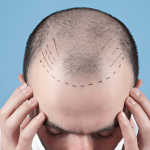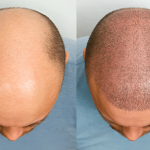Post Hair Transplant Care: 15 Do’s & Don’ts for Faster Recovery
Getting a hair transplant is just the first step toward achieving a fuller, natural-looking head of hair. Proper post-transplant care plays a vital role in ensuring successful graft survival and a faster recovery. At DHI International, we emphasize the importance of aftercare just as much as the procedure itself.
Why Aftercare Is Critical
A successful hair transplant doesn’t end when you leave the clinic—it begins there. Post-procedure care is just as crucial as the surgery itself. Whether you’ve chosen DHI’s Direct Hair Implantation method or another advanced technique, proper aftercare is essential to ensure optimal graft survival, prevent infections, and speed up recovery. In this blog, DHI International shares the top 15 do’s and don’ts to help you experience a smooth healing journey and enjoy long-lasting results.
Immediate Aftercare (First 48 Hours)
The first 48 hours after a hair transplant are critical for laying the foundation for proper healing. Here’s what you can expect during this period:
- Mild redness and swelling around the transplanted area
- Crust formation on the grafts as they begin to settle
- Sensitivity in both the donor and recipient areas
Tip from DHI International:
All patients receive a comprehensive aftercare kit, which includes a medical-grade shampoo, detailed instructions, and a specially designed soft pillow to minimize pressure on the grafts.
Do’s for Faster Hair Transplant Recovery
- Sleep in an Elevated Position
Sleep on your back with your head elevated at a 45-degree angle for at least 3–5 nights after surgery. This helps reduce swelling and prevents accidental damage to the grafts. - Use the Prescribed Shampoo Correctly
Around 48 hours post-transplant, gently wash your scalp using the special shampoo provided. Follow the washing technique exactly as instructed—avoid using direct water pressure. - Follow a Nutrient-Rich Diet
Include foods high in iron, biotin, vitamin E, and protein. Stay well-hydrated. A balanced diet strengthens your immune system and promotes faster tissue repair. - Wear the Recommended Cap (If Advised)
DHI may recommend a loose, soft cap after a few days to shield your scalp from dust and pollutants. Ensure it doesn’t come into contact with or rub against the grafts. - Stay Hydrated
Drink plenty of water daily. Proper hydration improves blood circulation and supports the healing of transplanted follicles. - Take Medications as Prescribed
Follow your DHI specialist’s instructions regarding antibiotics, anti-inflammatory medications, and pain relievers to prevent infection and minimize discomfort. - Moisturize the Donor Area
Apply the recommended lotion or spray to keep the donor area hydrated. Moisturizing helps reduce dryness, soothes irritation, and speeds up scab removal. - Attend Follow-Up Appointments
Never skip your follow-up visits. These appointments allow your surgeon to track your healing progress and address any concerns promptly.
Don’ts That Can Delay or Damage Your Results
- Avoid Sweating
For at least 10–14 days, steer clear of any physical activity that causes sweating—this includes gym workouts, running, or sauna sessions. Sweat can irritate grafts and increase the risk of infection. - Stay Out of the Sun
Direct sun exposure can damage the sensitive scalp and hinder healing. Wear a loose-fitting hat or remain indoors during peak sunlight hours for at least two weeks. - Don’t Scratch or Pick at Scabs
Itching and scabbing are part of the normal healing process. However, scratching or picking can dislodge grafts and lead to scarring or infection. - No Alcohol or Smoking
Avoid alcohol and smoking for at least one week post-transplant. Alcohol thins the blood and may interfere with medications, while smoking reduces oxygen supply to the follicles, slowing down recovery. - Avoid Hair Products and Styling Tools
Refrain from using gels, sprays, dryers, or straighteners during the first month. Even combing should be avoided in the transplanted area until it has fully healed. - No Swimming
Avoid swimming in pools or the sea for at least 3–4 weeks, as chlorine and bacteria can increase the risk of infection. - Don’t Wear Tight Helmets or Caps Too Soon
Tight helmets or headgear can rub against the grafts and dislodge them. Wait at least 2–3 weeks, or follow your DHI expert’s guidance before using any headwear.
Bonus Tips from DHI International Experts
- Graft Shedding is Normal: Don’t panic if transplanted hairs begin to fall out in 2–4 weeks. It’s part of the natural growth cycle.
- New Hair Growth Timeline: Expect new hair to start growing around 3–4 months, with visible improvement in 6 months and full results in 12–14 months.
- Consider PRP Therapy: Platelet-Rich Plasma (PRP) sessions after the transplant can enhance graft survival and hair density.
Timeline of Recovery (Week-by-Week)
Week 1: Healing Begins
Do: Rest adequately and avoid touching the scalp.
Don’t: Expose your scalp to direct sunlight or wear tight hats.
You may experience minor swelling and scabbing.
A saline spray and antibiotics will be prescribed to prevent infection and support healing.
Week 2: Shedding Starts
Do: Continue gentle scalp washing as per DHI’s aftercare instructions.
Don’t: Panic if you notice hair fall—this is expected.
This is the shock loss phase, where transplanted hairs shed to make way for new growth.
Weeks 3–4: Recovery Progresses
Do: Maintain a healthy diet to support tissue regeneration.
Don’t: Resume strenuous activities or gym workouts just yet.
Most visible signs of surgery—such as scabs and redness—begin to subside.
Months 2–3: Dormant Phase
Do: Be patient and remain consistent with your follow-up care.
Don’t: Use any chemical hair treatments or harsh products.
Hair growth may not yet be visible. This phase is essential for root development beneath the scalp.
Months 4–6: Visible Growth
Do: Hydrate and nourish your scalp regularly with doctor-approved products.
Don’t: Compare your progress to others—growth varies from person to person.
New hair starts to emerge, often fine and thin initially.
Months 6–12: Maturation Phase
Do: Continue protecting your scalp from sun exposure and harsh weather.
Don’t: Miss your follow-up appointments with DHI specialists.
Hair begins to thicken, darken, and take its final form, delivering fuller, natural-looking results.
Expert Tips from DHI Doctors
At DHI International, your journey doesn’t end after the procedure—it continues with personalized care. Our certified doctors create a customized post-transplant plan tailored to your scalp condition, graft type, and lifestyle. Here are their top expert tips to support optimal recovery and lasting results:
- Sleep upright at a 45-degree angle during the first week to minimize swelling.
- Use only DHI-recommended shampoos and lotions to gently cleanse the scalp without disturbing the grafts.
- Avoid alcohol and smoking for at least two weeks, as both can interfere with healing and reduce blood circulation to the follicles.
- Keep your scalp moisturized using a saline spray or doctor-approved solutions to support healing and reduce dryness.
- Do not scratch or rub the grafted area, even if it itches—this can dislodge grafts and affect results.
- Wear loose-fitting caps only after 10 days to protect your scalp from dust and sun exposure, without putting pressure on the grafts.
- Consider biotin-rich supplements, but only after consulting your physician to ensure they’re appropriate for your needs.
15 Do’s and Don’ts for Faster Recovery After a Hair Transplant
✅ DO’s:
Follow all post-operative instructions provided by your DHI specialist.
Use a mild, medicated shampoo for gentle and safe scalp cleansing.
Apply a cold compress on the forehead only (never on the graft area) to help reduce swelling.
Stay well-hydrated and maintain a balanced, nutrient-rich diet.
Attend all scheduled follow-up appointments to monitor your progress.
Use only clean towels and pillowcases to prevent bacterial infections.
Be patient—visible results take time, but the outcome is worth the wait.
❌ DON’Ts:
Don’t touch, scratch, or pick at the grafts, even if they itch.
Avoid smoking and alcohol, as they impair healing and reduce blood circulation.
Refrain from heavy exercise or any activity that induces sweating for at least two weeks.
Do not swim in chlorinated pools or seawater for at least four weeks.
Avoid using hair dryers or styling tools on or near the graft area.
Do not sleep flat on your back during the first week—keep your head elevated.
Never self-medicate—consult your doctor before taking any supplements or medications.
Do not dye or color your hair until six months post-surgery to protect the grafts.
FAQs on Post Hair Transplant Care
Q1: When can I wash my hair after the transplant?
A: You can begin gently washing your hair 48–72 hours after the procedure, as advised by your DHI specialist. Use only the prescribed shampoo and follow the recommended technique.
Q2: Is hair shedding after the transplant normal?
A: Yes, shedding typically occurs during the second to third week and is a completely normal part of the hair growth cycle. This phase is known as shock loss and allows new hair to grow.
Q3: Can I apply oil or serum post-transplant?
A: Avoid using oils or serums for at least one month. Always follow your doctor’s advice before applying any hair products to ensure they do not interfere with healing.
Q4: When will I see full results?
A: Noticeable hair growth usually begins around the 6-month mark. Full results, including thickness and density, typically appear within 12–14 months.
Ready to maximize your hair transplant results?
Visit your nearest DHI Clinic to get step-by-step recovery instructions, dietary tips, and expert product recommendations—all tailored to ensure the best outcome for your procedure.
Proper aftercare is the key to achieving natural-looking, long-lasting hair growth. With DHI International’s advanced techniques, expert support, and personalized care protocols, you’re not just restoring hair—you’re restoring confidence that grows.
Schedule a consultation at your nearest DHI Clinic today and get expert guidance on your recovery journey.
Act Now – Don’t Risk Your Investment
Your hair transplant is more than a procedure—it’s an investment in your confidence and appearance. Don’t let simple post-care mistakes compromise your results.
Follow DHI’s expert aftercare guidance to ensure a smooth recovery and a successful transformation.
Book your free post-transplant consultation or speak with a DHI recovery expert today to stay on track toward fuller, healthier hair.






